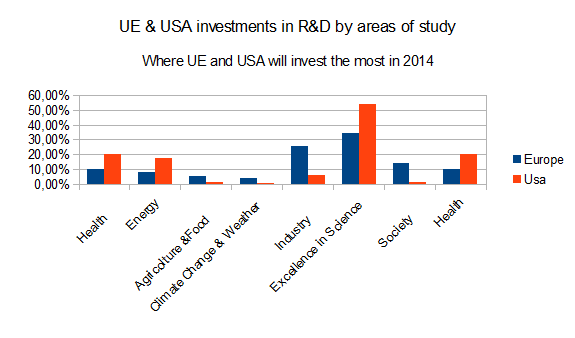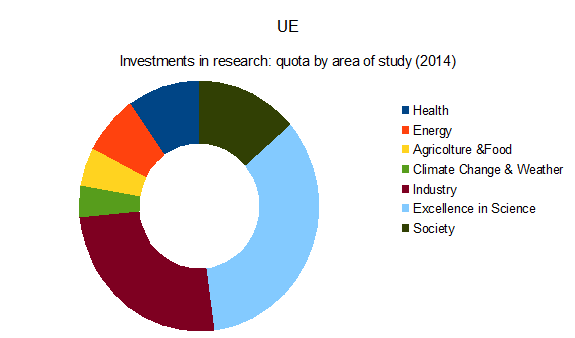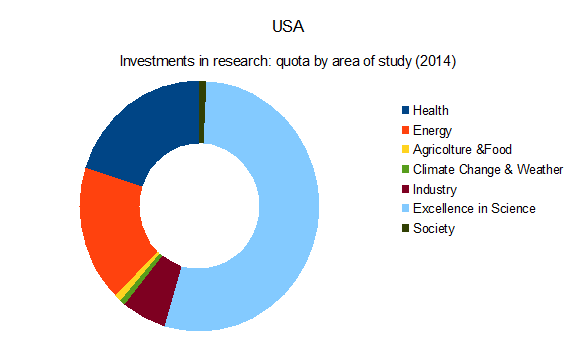Some weeks ago, the European Union
released the planned quotas of investment in research for 2014, the first year
of the new-born Horizon 2020 program. At the same time, on January 13th
the US Congress agreed on a budget, containing the American policy about
investments in research. Thus, is it possible to predict in which directions EU
and US research will go, by comparing these two draft budgets? Will these two
policies merge or not?
Sources and methodology
Generally speaking, it is always
hard to compare such different budgets: the US adopt a federal budget, while
the European Union has a confederate one. Moreover, there are differences in
approaches, definitions and institutions (the ESA doesn't have all the power NASA
has, for example). Keeping in mind these basic problems, the two budgets are
comparable, but this is meant to suggest a scenario, it is not a scientific
economic comparison.
It has been chosen to compare quotas
of the entire budget amount. This is justified by the fact that this preserve
data from volatility of money exchange market and inflation rates.
A defined amount of money for each area of study is given only for the US
budget, through the FY2014
Omnibus Appropriation Bill. The source for the European shares of the budget is the First
Amending Letter to 2014 Budget.

General overview
- Europe is concentrated in solving his economic and financial crisis, thus 25% of H2020 budget for 2014 is dedicated to foster continental industry through scientific research (less than 6% of total funding in the US, where private entrepreneurship plays the major role). Other clearly relevant issues are food safety, agriculture (and fishery), global climate change and societal challenges (mainly elderly of the European population), but with very low quotas (about 5% each).
- On the contrary, US public money, during this year, will be spent on cutting edge research. In other words, the US adopted a mid-term approach, while Europe a short term one. That's clear by seeing that more than half of US public funding will be given to excellence in science, namely the best research that is not strictly linked with markets. Other indicators of this trend is the share given to health and energy related research, two areas in which outputs need more than few years to be marketable.
- Conclusion. European Union and US policies are different in funding research, both relating to areas and timing for marketable results.


Shares of budgets by area
- Health: the big differences between the quotas given to health and medical research in the EU and in the US (where it is more than doubled) can be explained by keeping in mind two thing. First, in Europe this kind of research is strongly funded at the national stage. In other words, Europe surely spend a lot more money in health research than the quota reported, but it is quite difficult to aggregate all the national data. At the same time, however, many minor countries rely their R&D investments on the European funding. These two factors lead to say that, anyway, the US will invest more than EU in health and medical research in 2014.
- Energy: Europe will give a quota less than a half in comparison with the US. These data could be explained as above. Although great proclamations, finding new or better ways to use energy is not a major priority for Europe in 2014.
- Agriculture and food: this area is quite large and heterogeneous. The Food and Drugs Administration (FDA) budget is not counted in the US quota, even because the FDA receives partial funds from the private sector (as the European counterpart, the EMA, does). Having cleared this, it is reasonable to say that results may not vary a lot: on these issues, Europe is investing in research more than the United States.
- Climate change: it is clear that the climate change is not a national problem, nor even regional. It is global one. Anyway, the US and the EU are the most industrialized areas in the world. But their strategies are different. On one side, United States are investing a lot in finding more precise forecasting models and infrastructures about extreme weather conditions. It can be seen as a “domestic” view of the problem, such as, for instance, typhoon and hurricanes predictions. On the contrary, Europe endorsed a global approach. However, the EU will invest 4 times more than the US on these issues: that's a clear priority indicator.
- Industry: it is widely known that private sector and private investments are basic pillars of the entire galaxy of American values. On the contrary, even the strongest supporters of lasseiz-faire among the European countries are trying to help firms with public funding, especially during this financial crisis. These different mindsets are clearly showed by the quotas: Europe, during 2014, will give almost five times more money than US to the industry-oriented scientific researches.
- Excellence in science: as said before, Europe is clearly pushing towards applied science, as shown by the industry rates. On the contrary, the US are orienting their financial support towards excellence in science, by giving money to those fields which are unlikely to be funded by private sector (such as, for instance, astronomy) and by giving the private sector the commitment for bringing the scientific researches into the markets. It has to be underlined that United States funds excellence in science mostly through military institutions, a model which is very different from the European one.
- Society: this area is very difficult to define, especially on the US side. In calculating the quota, two parameters have been mainly considered: funds for studying social sciences and funds toward implementation of transportation efficiency (as transports, in a world of growing population, are becoming a huge issue). This means, for instance, that while in Horizon 2020 there is a precise item of expenditure about “secure societies” a correspondent item in the US budget cannot be found. Given this, the European Union will invest more in “exploring its society” than the US will do.

